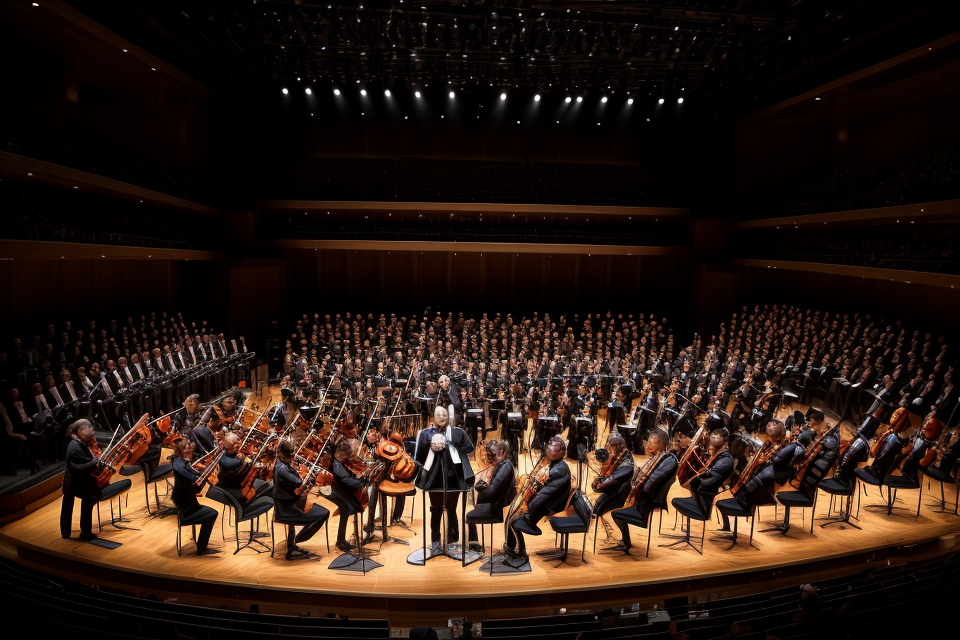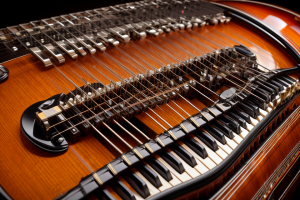
Music is a universal language that connects people from all walks of life. The power of music lies in its ability to evoke emotions and inspire change. But what is the most powerful musical instrument? This question has been debated for centuries, with no clear answer. Some may argue that the piano, with its vast range of tones and dynamics, holds the most power. Others may suggest that the guitar, with its versatility and simplicity, is the most powerful instrument. Still, others may point to the drums, with their ability to create rhythm and energy. Ultimately, the answer to this question may depend on personal preference and the context in which the music is being played. So, let’s explore the topic and see what we can uncover about the most powerful musical instrument.
It is difficult to determine the most powerful musical instrument as it depends on various factors such as the intended use, the skill of the player, and the cultural context. However, some instruments are often considered to be more powerful than others due to their ability to produce a wide range of sounds and dynamics, their versatility in different musical genres, and their emotional impact on listeners. These instruments include the piano, the guitar, the violin, and the drums. Ultimately, the most powerful musical instrument is the one that can convey the desired message or emotion to the listener, regardless of the instrument’s technical capabilities.
Exploring the Concept of Power in Musical Instruments
The Definition of Power in Musical Instruments
Power in musical instruments can be defined in several ways. One way to define power is in relation to the instrument’s sound output. In this context, a powerful instrument is one that can produce a rich, full sound that can fill a room or a concert hall. This type of power is often associated with instruments like the pipe organ, which can produce a sound that is both loud and complex, with multiple harmonies and overtones.
Another way to define power in musical instruments is in relation to the instrument’s ability to affect listeners. In this context, a powerful instrument is one that can evoke strong emotions or create a profound impact on the listener. This type of power is often associated with instruments like the human voice, which can convey a wide range of emotions and feelings, from joy and happiness to sadness and sorrow.
In both cases, the definition of power in musical instruments is closely tied to the instrument’s ability to create a powerful musical experience for the listener. Whether it’s through the sheer force of the instrument’s sound or the emotional impact of the music it produces, a powerful musical instrument has the ability to transport the listener to another world and create a profound connection between the music and the listener.
Factors that Contribute to an Instrument’s Power
The power of a musical instrument is a complex and multifaceted concept that can be influenced by various factors. Here are some of the most important factors that contribute to an instrument’s power:
The instrument’s size and design
The size and design of an instrument can have a significant impact on its power. For example, a grand piano is generally considered to be more powerful than a digital piano or a keyboard, not only because of its larger size but also because of its superior sound quality and range of dynamics. Similarly, a bass guitar with a larger body and more strings is likely to produce a more powerful sound than a smaller model.
The player’s skill and technique
The skill and technique of the player can also play a crucial role in determining an instrument’s power. A virtuoso musician who has mastered their instrument can extract a wide range of sounds and dynamics from it, making it seem more powerful than it actually is. On the other hand, a less skilled player may struggle to produce a powerful sound, even with a well-designed instrument.
The musical context in which the instrument is used
Finally, the musical context in which an instrument is used can also affect its power. For example, a brass instrument like a trumpet may be considered more powerful in a marching band context, where its bright and piercing sound can cut through the noise of the crowd. In a symphony orchestra, however, the timpani may be considered the most powerful instrument, due to its ability to produce a deep and resonant sound that can fill a concert hall.
The Contenders: The Most Powerful Musical Instruments
The Piano
Power in Sound Output
The piano is renowned for its ability to produce a wide range of sounds, from delicate and nuanced to bold and powerful. This is due to the instrument’s design, which utilizes a series of keys, strings, and hammers to create sound. When a pianist presses a key, a hammer strikes a string, causing it to vibrate and produce a specific tone. The piano’s keyboard allows for a vast array of notes to be played, and the addition of pedals can alter the sound further, adding depth and richness.
Power in Emotional Impact
In addition to its technical capabilities, the piano also holds a unique power in its ability to evoke strong emotions in listeners. From the gentle melodies of a solo piano piece to the dramatic chords of a symphony, the piano has the ability to convey a wide range of emotions. Its versatility and expressiveness make it a popular choice for composers, and its popularity among musicians and audiences alike is a testament to its emotional power.
Whether it’s through the intricate fingerwork of a virtuoso or the simple melodies of a beginner, the piano has the ability to captivate and move those who listen to it. Its combination of technical prowess and emotional resonance make it a formidable contender for the title of the most powerful musical instrument.
The Guitar
Power in Versatility
The guitar is an instrument that is capable of producing a wide range of sounds, from soft and melodic to loud and intense. Its versatility lies in its ability to be played in different styles, such as rock, blues, jazz, and classical music. This allows the guitar to be used in a variety of settings, from small coffee shops to large concert halls.
Power in Cultural Influence
The guitar has had a profound impact on popular culture around the world. It has been featured in countless songs, movies, and television shows, and has become a symbol of coolness and rebellion. Many famous musicians have made the guitar their primary instrument, including Jimi Hendrix, Eric Clapton, and Carlos Santana. The guitar’s influence can also be seen in fashion, with many people wearing clothing and accessories that feature the instrument.
Overall, the guitar is a powerful musical instrument due to its versatility and cultural influence. Its ability to produce a wide range of sounds and be played in different styles has made it a popular choice among musicians, while its association with coolness and rebellion has made it a cultural icon.
The Violin
Power in Technical Demands
The violin is an instrument that demands technical prowess from its players. From the precise bowing technique to the intricate fingerwork required for complex scales and arpeggios, the violin presents a formidable challenge to musicians of all skill levels. The intricate mechanics of the instrument, including the subtle variations in tone and dynamics, require a mastery of technique that is truly remarkable.
Power in Emotional Range
In addition to its technical demands, the violin is also a powerful instrument in terms of its emotional range. Its haunting melodies and soaring harmonies have the ability to evoke deep emotions in listeners, from sadness and longing to joy and triumph. The expressiveness of the violin is unparalleled, and its ability to convey a wide range of emotions has made it a staple of classical music for centuries.
From its intricate construction to its complex mechanics, the violin is a true masterpiece of engineering and design. Its power lies not only in its technical demands and emotional range, but also in the skill and artistry of the musicians who play it. Whether in the hands of a virtuoso soloist or a talented ensemble, the violin remains one of the most powerful musical instruments in the world.
The Drums
Power in Rhythmic Complexity
The drums have the power to drive a rhythm forward, creating a sense of momentum and energy that can captivate an audience. From the steady beat of a snare drum to the complex polyrhythms of a drum kit, the drums have the ability to create intricate rhythmic patterns that can captivate even the most seasoned musician. The power of the drums lies in their versatility, allowing them to be used in a wide range of musical genres from rock to jazz to classical music.
Power in Energy and Excitement
The drums also have the power to generate excitement and energy in a performance. The sheer volume and intensity of a drum set can fill a room with sound, creating a powerful presence that demands the listener’s attention. The drums’ ability to create dynamic contrasts, from soft to loud, can also add an extra layer of excitement to a performance. This power is particularly evident in live performances, where the energy of the drums can be felt by both the performers and the audience.
Furthermore, the drums’ power to generate excitement and energy can also be harnessed in other forms of music-making, such as recording sessions. The use of drums in a recording can add a sense of urgency and excitement to a song, making it more dynamic and engaging for the listener. The drums’ power to generate energy is also evident in the many different types of drums available, from the bass drum to the hi-hat, each with its own unique sound and energy.
In conclusion, the drums have the power to drive a rhythm forward, create intricate rhythmic patterns, generate excitement and energy, and can be used in a wide range of musical genres. The drums’ versatility and intensity make them a formidable contender for the title of the most powerful musical instrument.
The Brass Section
The brass section is one of the most powerful and dynamic sections in an orchestra or ensemble. It is comprised of instruments such as the trumpet, trombone, French horn, and tuba, each with its own unique sound and characteristics.
- Power in volume and projection: Brass instruments are known for their ability to produce a powerful and projecting sound, making them ideal for solo and ensemble performances. They can be heard over other instruments and can fill a concert hall with sound.
- Power in dynamic range: Brass instruments also have a wide dynamic range, meaning they can play softly or loudly with great control. This allows brass players to create a wide range of expression and mood in their playing, from subtle nuances to bold and dramatic statements.
Additionally, the brass section has the ability to play in unison or in harmony, creating a rich and full sound. This makes them an essential part of many genres of music, from classical to jazz and beyond.
The Woodwinds
The woodwinds category encompasses a range of instruments, including the flute, clarinet, saxophone, and oboe, among others. These instruments are characterized by their ability to produce sound through the vibration of a reed or a lip plate, which creates a unique timbre and tone.
Power in melodic expressiveness
One of the primary strengths of woodwind instruments is their ability to convey a wide range of emotions and moods through melody. The fluid, expressive nature of woodwind instruments makes them particularly well-suited for conveying subtle shades of emotion and mood. For example, the soft, airy sound of a flute can evoke a sense of peace and tranquility, while the sharp, piercing sound of a clarinet can create a sense of urgency and tension.
Power in tonal color
Another significant advantage of woodwind instruments is their ability to produce a wide range of tonal colors. Each woodwind instrument has a distinct timbre, ranging from the bright, silvery sound of a flute to the warm, rich sound of a saxophone. These different timbres allow woodwind players to create a diverse range of textures and moods in their music.
Moreover, woodwind instruments can produce a wide range of dynamics, from soft, delicate pianissimo passages to loud, forceful fortissimo statements. This dynamic range allows woodwind players to create a sense of depth and contrast in their music, making it more engaging and emotionally resonant for listeners.
In summary, the woodwinds category of musical instruments is incredibly powerful due to their ability to convey a wide range of emotions and moods through melody and their ability to produce a wide range of tonal colors and dynamics. Whether playing a tender love song or an exuberant dance number, woodwind instruments are essential tools for any musician looking to express themselves musically.
FAQs
1. What is the most powerful musical instrument?
There is no definitive answer to this question as it depends on various factors such as the type of music, the context in which the instrument is played, and the skill of the musician. However, some instruments are considered to be more powerful than others due to their ability to produce a wide range of sounds, dynamic range, and versatility. Some examples of such instruments include the piano, guitar, and drums.
2. What makes a musical instrument powerful?
A musical instrument can be considered powerful if it has a wide range of tonal capabilities, a strong dynamic range, and the ability to produce a variety of timbres and textures. Additionally, an instrument that is easy to play and allows for a high level of control over sound production can also be considered powerful.
3. Is a larger instrument always more powerful than a smaller one?
Not necessarily. While larger instruments may have a wider range of tonal capabilities and a stronger dynamic range, smaller instruments can be just as powerful, especially when played by a skilled musician. The size of an instrument does not necessarily determine its power, but rather the skill of the musician playing it and the context in which it is played.
4. Are electronic instruments more powerful than acoustic ones?
This is a matter of personal opinion and can depend on the context in which the instrument is played. Electronic instruments, such as synthesizers and digital pianos, can produce a wide range of sounds and effects that may not be possible with acoustic instruments. However, acoustic instruments, such as the piano and guitar, have a unique sound and expressiveness that cannot be replicated by electronic instruments.
5. Which musical instrument is the most versatile?
Again, this is a matter of personal opinion and can depend on the context in which the instrument is played. However, some instruments are considered to be more versatile than others due to their ability to produce a wide range of sounds and styles of music. Examples of such instruments include the piano, guitar, and drums.







